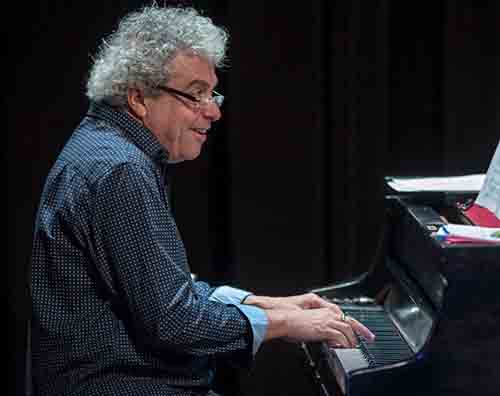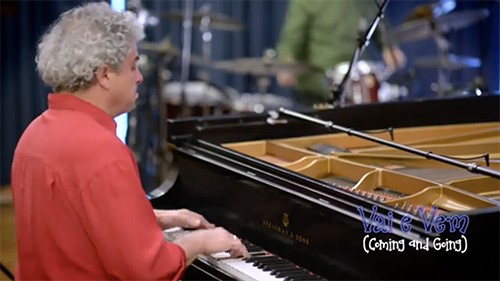
Jovino Santos Neto
Three-time Latin Grammy nominee Jovino Santos Neto, a master pianist, composer and arranger, is among the top Brazilian musicians working today.
Live Seminar Resources
Live Seminar Resources
PDF Downloads
- Balanço Zona Sul - lead sheet
Join PianoGroove Pro to access all downloads and learning resources.
Download theory supplements, midi files, chord changes and full note-for-note transcriptions of every lesson.
Seminar Description
Seminar Description
Understanding Cadences & Resolutions in Jazz Piano
Welcome to this lesson where we explore the essential concepts of cadences, resolutions, and harmonic motion in jazz piano. This session is particularly valuable for those looking to deepen their understanding of harmonic relationships and how chords resolve in a natural and fluid way.
By the end of this lesson, you will gain insight into the way cadences function, how tension and resolution work, and how to apply these ideas when playing jazz standards and Brazilian music.
What Are Cadences & Resolutions?
In music theory, the concept of "resolution" refers to the way musical tension is resolved. A cadence, on the other hand, is a specific harmonic movement that leads to a sense of closure.
- A cadence can be thought of as a falling motion, similar to gravity pulling an object down.
- A resolution is a way to move from instability (tension) to stability (release).
These ideas are central to jazz harmony, where common progressions such as the 2-5-1 and variations of dominant resolutions shape the sound of the genre.
The Role of Gravity in Music
While music does not have physical gravity like the real world, it has a harmonic gravity, where certain notes and chords "pull" toward each other. This is why a G7 naturally resolves to Cmaj7—our ears expect the movement, similar to how we expect a ball to fall when thrown in the air.
A great way to understand this concept is by visualizing orbits: just as planets revolve around a star, notes and chords revolve around a tonal center. The dominant chord (5) pulls toward the tonic (1), and various extensions and alterations can influence how strongly that pull is felt.
Expanding the 2-5-1 Progression
One of the most fundamental cadences in jazz is the 2-5-1 progression, which consists of:
- D-7 → G7 → Cmaj7 (in the key of C major)
This progression is the backbone of countless jazz standards, but it can be extended further with additional harmonic motion:
3-6-2-5-1: Expanding the cadence by adding the 3rd and 6th chords
- Example: E-7 → A7 → D-7 → G7 → Cmaj7
Tritone Substitutions: Swapping the dominant chord for another a tritone away
- Example: D-7 → Db7 → Cmaj7 instead of D-7 → G7 → Cmaj7
Chromatic Passing Chords: Adding smooth voice leading
- Example: D-7 → G7 → G#7 → Cmaj7
By using these techniques, we create movement and variation while still maintaining a sense of resolution.
Applying These Concepts to Brazilian Music
Brazilian jazz and bossa nova rely heavily on fluid harmonic motion, where dominant chords and resolutions are constantly shifting.
In the song "Balanço Zona Sul" by Tito Madi, we see:
- A floating rhythmic feel, emphasizing binary swing rather than straight four-beat phrasing.
- Use of chromatic passing chords and rich dominant extensions to create a natural sway, much like the rhythm of ocean waves.
- A sense of constant movement through cadences and resolutions, making the music feel harmonically elastic.
Five Practice Tips
- Visualize Gravity in Harmony – Think of dominant chords as having "pull" towards their resolution. Play G7 to Cmaj7 and feel the natural resolution.
- Expand 2-5-1 Progressions – Practice playing 3-6-2-5-1 progressions in different keys to hear how tension and release evolve.
- Experiment with Tritone Substitutions – Try swapping G7 for Db7 in a 2-5-1 to see how it changes the harmonic color.
- Think of Music as Motion – Play through progressions without stopping, visualizing each chord as a step in an ongoing movement rather than a static shape.
- Listen to Brazilian Jazz for Inspiration – Study the way bossa nova and samba incorporate harmonic movement, particularly in compositions by Antonio Carlos Jobim and João Donato.
By mastering cadences and resolutions, you’ll develop a deeper intuition for jazz harmony and be able to play with more confidence, fluidity, and expression. Happy practicing!






I enjoyed your discussion of the extended progressions very much. It was helpful seeing how you constructed your chords which often involved only the base note in your left hand. I wish that you would notate the Latin rhythm of a particular song in the notes and review it slowly in the beginning of the discussion. Thanks